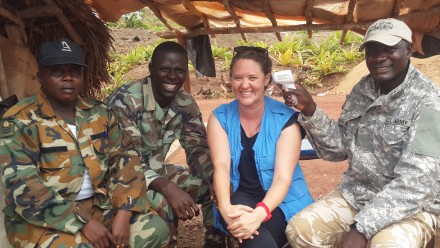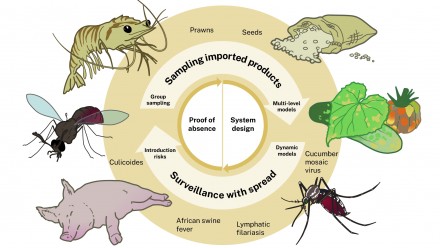Infectious disease epidemiology and modelling
About
This theme applies multidisciplinary approaches to emerging issues in communicable diseases. We combine strengths in research, education and the disciplines of field-based epidemiology, health services research and mathematical modeling to translate research findings into policy and practice.
Members
Leaders
Researchers
- Dr Samantha Colquhoun
- Dr Emma Field
- Associate Professor Brett Lidbury
- Dr Angus McLure
- Dr Amy Elizabeth Parry
- Dr Tehzeeb Zulfiqar
Research support officer
Collaborator
Students
External members
- Belinda Barnes
Projects
Publications
Recent publications
Applied epidemiology
- Davis S, Fearnley E, Viney K, Patel M, Kirk M. The Australian Master of Applied Epidemiology Program: Looking back, moving forward. Communicable Diseases Intelligence, 2016; (in press).
- Kirk MD, Davis S, Viney K Ebola outbreak in West Africa: considerations for strengthening Australia’s international health emergency response, MJA, 2016; 205(5):236-7.
- Guthrie J, Dance PR, Kelly PM, Lokuge K, McPherson M, Faulkner S Public health capacity development through Indigenous involvement in the master of applied epidemiology program - celebrations and commiserations. Australian Aboriginal Studies, 2011; 2:102-110.
- Foxwell AR, Roberts L, Lokuge K, Kelly PM Transmission of influenza on international flights,Emerg. Infect. Dis. 2009; 17:1188-1194.
- Jardine A, Menzies RI, Deeks SL, Patel MS, McIntyre PB The impact of pneumococcal conjugate vaccine on rates of myringotomy with ventilation tube insertion in Australia. Pediatr. Infect. Dis. J. 2009; 28:761-765.
- McPherson ME, Kelly H, Patel MS, Leslie D. Persistent risk of tuberculosis in migrants a decade after arrival in Australia. MJA 2008;188(9):528-531.
- Franklin LJ, Fielding JE, Gregory J, Gullan I, Lightfoot D, Poznanski SY, Vally H ‘An outbreak of Salmonella Typhimurium 9 at a school camp linked to contamination of rainwater tanks’, Epidemiology and Infection, 2008; 137(3), pp. 434–440.
- Webby RJ, Carville KS, Kirk MD, Greening G, Ratcliff RM, Crerar SK, Dempsey K, Sarna M, Stafford R, Patel M, Hall G Internationally Distributed Frozen Oyster Meat Causing Multiple Outbreaks of Norovirus Infection in Australia Clin Infect Dis. 2008; 44 (8): 1026-1031.
Infectious disease modelling
- Hogan AB, Anderssen RS, Davis S, Moore HC, Lim FJ, Fathima P, Glass K. Time series analysis of RSV and bronchiolitis seasonality in temperate and tropical Western Australia. Epidemics 2016;16 49-55.
- Sharmin S, Glass K, Viennet E, Harley D. Interaction of mean temperature and daily fluctuation influences dengue incidence in Dhaka, Bangladesh. PLOS Neglected Tropical Diseases, 2015; 9(7):e0003901.
- Aditama TY, Samaan G, Kusriastuti R, Sampurno OD, Purba M, Santoso H, Bratasena A, Marruf A, Sariwati E, Setiawaty V, Glass K, Lokuge K, Kelly PM, Kandu IN. Avian influenza H5N1 transmission in households, Indonesia. PLOS One, 2013; 7(1):e29971
- Fielding J, Kelly HA, Mercer GN, Glass K, Systematic review of influenza A(H1N1)pdm09 virus shedding: duration is affected by severity but not age. Influenza and other respiratory viruses, 2013; 8(2):142-150.
- Hickson RI, Mercer GN, Lokuge KM. A metapopulation model of tuberculosis transmission with a case study from high to low burden areas. PLOS One, 2012; 7(4):e34411.
- Mercer GN, Glass K, Becker NG. Effective reproduction numbers are commonly overestimated early in a disease outbreak. Statistics in Medicine, 2011; 30:984-994
- Caley P, Philp DJ, McCracken K. Quantifying social distancing arising from pandemic influenza. J Roy Soc. Interface, 2008; 5(23):631-639.
- Park AW, Glass K.Dynamic patterns of avian and human influenza in east and southeast Asia. Lancet: Infectious Diseases, 2007; 7: 543-548.
- Caley P, Becker NG, Philp DJ The waiting time from inter-country spread of pandemic influenza. PLOS One, 2007; 2(1):e143.
- Glass K, Barnes B. How much would closing schools reduce transmission during an Influenza pandemic? Epidemiology, 2007; 18: 623-628.
Foodborne diseases
- Kirk MD, Pires SM, Black RE, Caipo M, Crump JA, Devleesschauwer, Dopfer D, Fazil A, Fischer-Walker CL, Hald T, Hall AJ, Keddy KH, Lake RJ, Lanata CF, Togerson PR, Havelaar AH, Angulo FJ (2015) World Health Organization estimates of the global and regional disease burden of 22 foodborne bacterial, protozoal and viral diseases, a data synthesis. PLOS Medicine, 2010; 12(12):e1001940
- Lal A, Cornish LM, Fearnley E, Glass K, Kirk M. Cryptosporidiosis: a disease of tropical and remote areas in Australia. PLOS Neglected Tropical Diseases, 2015; 9(9):e0004078.
- Kirk M, Ford L, Glass K, Hall G. Foodborne illness, Australia, circa 2000 and circa 2010.Emerging Infectious Diseases, 2014; 20(11):1857-64.
- Ford L, Kirk MD, Glass K, Hall G. Sequelae of foodborne illness caused by 5 pathogens, Australia, Circa 2010. Emerging Infectious Diseases, 2014; 20(11):1865-1871.
- Chen Y, Kirk MD Incidence of acute respiratory infections in Australia. Epidemiology and Infection, 2014; 142(7):1355-1361.
- Fearnley E, Raupach J, Lagala F, Cameron S (2011) Salmonella in chicken meat, eggs and humans; Adelaide, South Australia, Int. J. Food Microbiology, 2008; 146:219-227.
- Kirk MD, Fullerton KE, Hall GV, Gregory J, Stafford R, Veitch MG, Becker N.Surveillance for outbreaks of gastroenteritis in long-term care facilities, Australia, 2002-2008. Clinical Infectious Diseases. 2010; 51:907-14.
- Kirk MD, McKay I, Hall GV, Dalton CB, Stafford R, Unicomb L, Gregory J. Foodborne disease in Australia: the OzFoodNet experience,2008.
- D’Souza RM, Hall G, Becker NG Climatic factors associated with hospitalizations for rotavirus diarrhoea in children under 5 years of age. Epidemiology and Infection 2008;136:56-64.
- Hall G, Yohannes K, Raupach J, Becker N, Kirk M. Estimating community incidence of Salmonella, Campylobacter, and Shiga toxin-producing Escherichia coli infections, Australia. Emerg Infect Dis. 2008; Oct;14(10):1601-9









